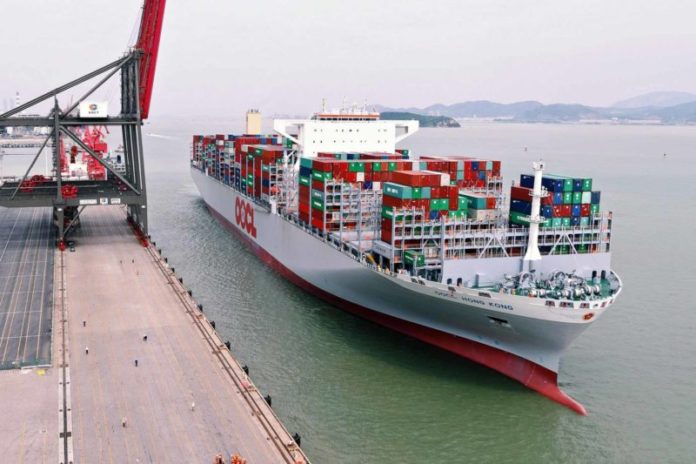-
Waning US consumer confidence amid rising inflation and weak economic outlook keeps container freight market players edgy this peak season and beyond
-
Trans-Pacific volumes and booking inquiries had fallen further in the final weeks Q2 2022 amid lower vessel utilization out of Asian gateways, Platts reports
-
Ample spot market space out of China reported since volumes fell during the Shanghai lockdowns coincided with a 10% drop in North Asia-North America freight volume
Consumer gloom in the United States amid rising inflation and weak economic outlook is keeping container freight market participants edgy over the peak import season and beyond, according to market analysis.
A container market insight from Platts on International Shipping News said Trans-Pacific volumes and booking inquiries had declined further in the final weeks of the second quarter as shipowners reported lower vessel utilization out of Asian ports.
The report said booking inquiries for US imports remain under pressure and quoted one shipowner source as noted that “spot market space is ample out of China.”
In-kind freight on the North Asia-North America run had been under pressure in Q2 as pockets of vessel space had opened up. PCR13 –North Asia-to-West Coast North America – slid 10% in Q2, coinciding with a dip in volumes since the extensive lockdowns in and around Shanghai that began to unwind June 1, said analyst Jon Monroe.
Monroe said volumes have failed to rebound to meet prior expectations, while consumer appetite appears to have waned in the US, and large retailers have been heard cutting back orders amid an abundance of inventory.
“Forecasts from BCOs (beneficial cargo owners) and NVOCCs (non-vessel operating common carriers) alike show a weakness in the Trans Pacific East Bound market through June, possibly mid-July …. Other importers moved peak season goods earlier than usual to avoid anticipated space issues similar to the problems they had in [Q3] 2021,” said Monroe.
This has prompted widespread uncertainty among market participants as to the magnitude of the North American peak import season, which runs between July and September, the report said. It said many sources expect volumes to peak at lower levels than originally projected.
China’s COVID-related lockdowns came as US consumer demand tapered off, with total US imports down by 63,000 TEUs between March and April to 2.56 million TEU, according to Hackett Associates.
Total TEU throughput at Port of Los Angeles registered negative growth for the first time this year in April and May, falling 6.29% and 4.36%, respectively. Nearby Port of Long Beach saw a 1.7% decrease in May, the first since last December. Loaded imports alone slid 6.67% in May at the Port of Los Angeles.
“We do see the beginnings of a decline in the growth rate of imports in the second half of the year,” said Hackett Associates in its Global Port Tracker report.
“Despite this, we expect to see continued shipping capacity constraints and a likelihood of a recovery in freight rates from their recent declines … as the uptick in volumes from China is felt.”
Loaded imports are well above pre-pandemic averages, particularly at key US East Coast ports, where volumes have remained strong. The Port of New York/New Jersey reported a 15.6% bump in loaded imports in April and has not seen negative throughput growth since February 2021.
Much of the volume growth on the Eastern Seaboard has been attributed to shippers looking to reroute cargoes away from congested West Coast ports in a bid to hedge on market-wide constraints. Looming expiry of the West Coast longshoremen’s contract could lead to a slowdown, or, less likely, stoppage of cargo-handling at Pacific Coast container ports.
The WCLU’s labor contract expired July 1, ending a no strike/no lockout agreement between employers and workers’ unions.
While most market watchers do not expect a strike to occur, there are residual fears of a cargo handling slowdown at US West Coast container gateways. Three of the last four negotiations between the union and employers led to temporary work stoppage before a deal could be struck.
“A lot of what happens in the next 60-90 days depends on what happens with ILWU negotiations,” said a freight forwarder.
Pacific Coast ports have seen some normalization in congestion and vessel backups. Just 16 vessels were at anchor or slow steaming towards the ports of Los Angeles/Long Beach on June 29, the SoCal Marine Exchange said. That was well below the 109 vessels counted in Q1 2022.
Intermodal network constraints aren’t the only headwinds that cargo owners face, as freight rate spreads for boxes into the East Coast versus those to the West Coast are above historical levels.
The differential between PCR13 (North Asia-to-US West Coast) and PCR5 (North Asia-to-East Coast) was US$2,500/FEU on June 30, up from the 2021 average of US$1,229/FEU. The spread peaked at US$4,500/FEU April 11 and averaged $2,840/FEU in Q2 2022, according to Platts.





